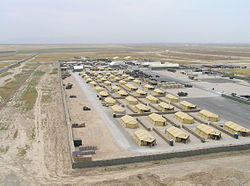This article needs additional citations for verification .(March 2013) |
Camp Marmal | |||||||||||||||
|---|---|---|---|---|---|---|---|---|---|---|---|---|---|---|---|
 A United States C-5 aircraft at Mazar-e-Sharif Airport, adjacent to Camp Marmal, on 22 May 2012 | |||||||||||||||
| Summary | |||||||||||||||
| Airport type | Military | ||||||||||||||
| Owner | | ||||||||||||||
| Serves | Northern Afghanistan | ||||||||||||||
| Location | Mazar-i-Sharif, Afghanistan | ||||||||||||||
| Built | 2005 | ||||||||||||||
| In use | 2005-2021 | ||||||||||||||
| Elevation AMSL | 1,273 ft / 388 m | ||||||||||||||
| Coordinates | 36°42′10″N067°13′40″E / 36.70278°N 67.22778°E | ||||||||||||||
| Map | |||||||||||||||
 | |||||||||||||||
| Runways | |||||||||||||||
| |||||||||||||||
Camp Marmal was an installation of the Afghan Armed Forces. It was adjacent to Maulana Jalaluddin Balkhi International Airport in Mazar-i-Sharif, Afghanistan, at the foot of the Hindu Kush mountains. The camp was opened in September 2005. The camp gets its name from the bordering Marmal Mountains. Prior to the withdrawal of German troops, it was the largest base of the Bundeswehr outside Germany.
Contents
Camp Marmal hosted the troops of Train Advise Assist Command – North belonging to the NATO Resolute Support Mission which succeeded the International Security Assistance Force in 2014.
The base had a large medical center for the German forces, their NATO allies, and local civilians. The base supported German combat operations in Afghanistan in early 2009.




